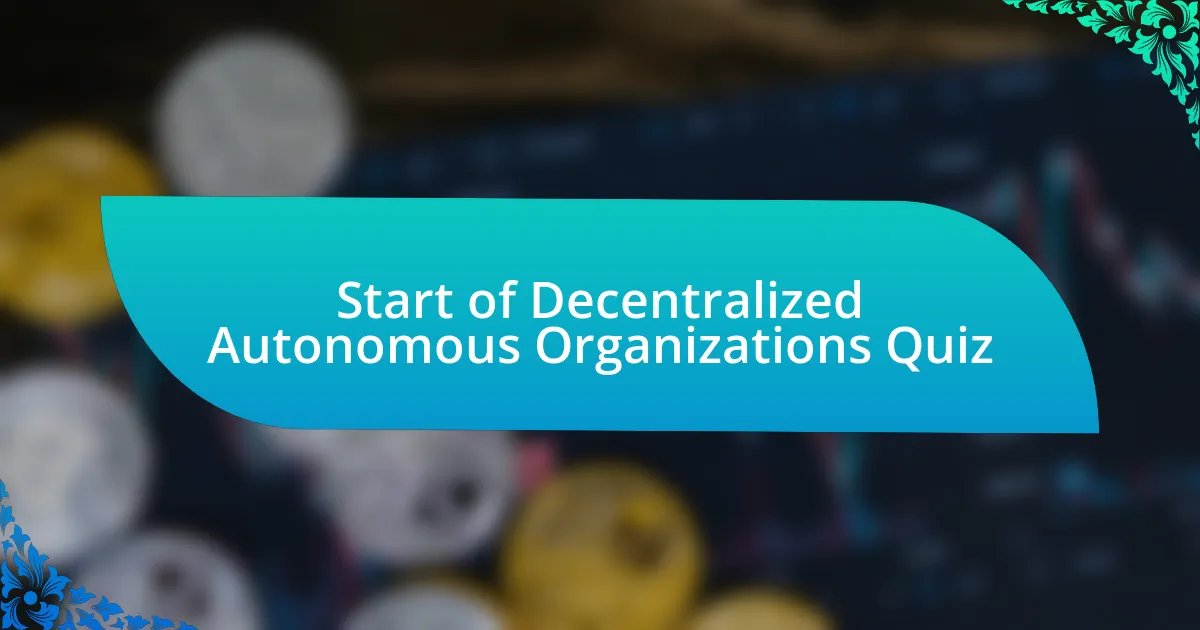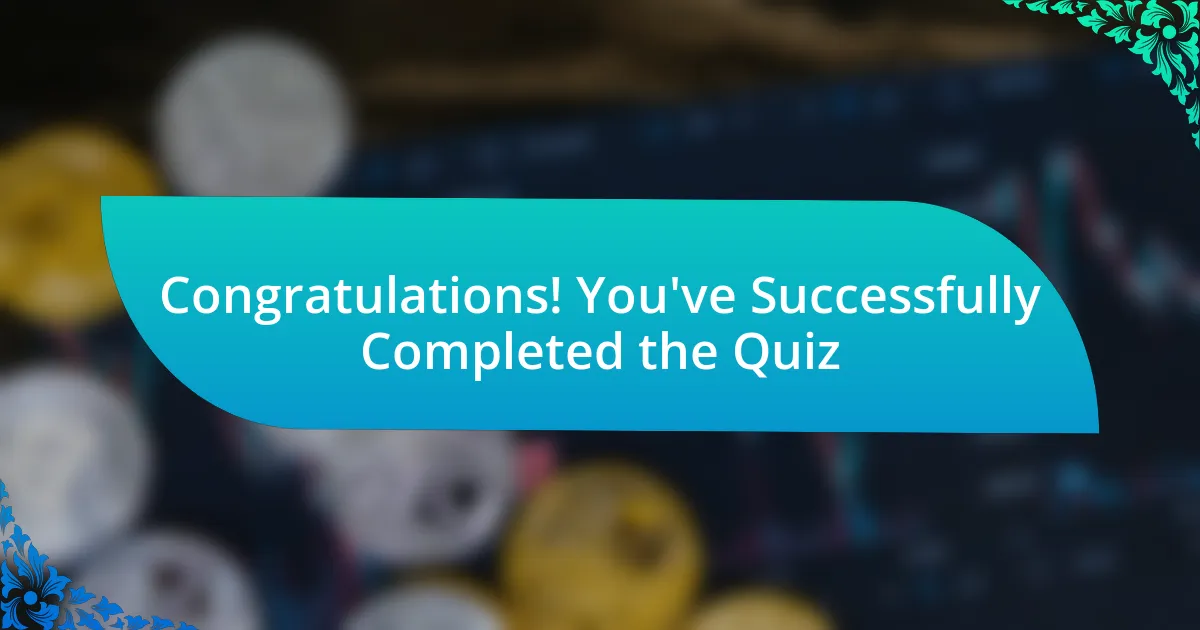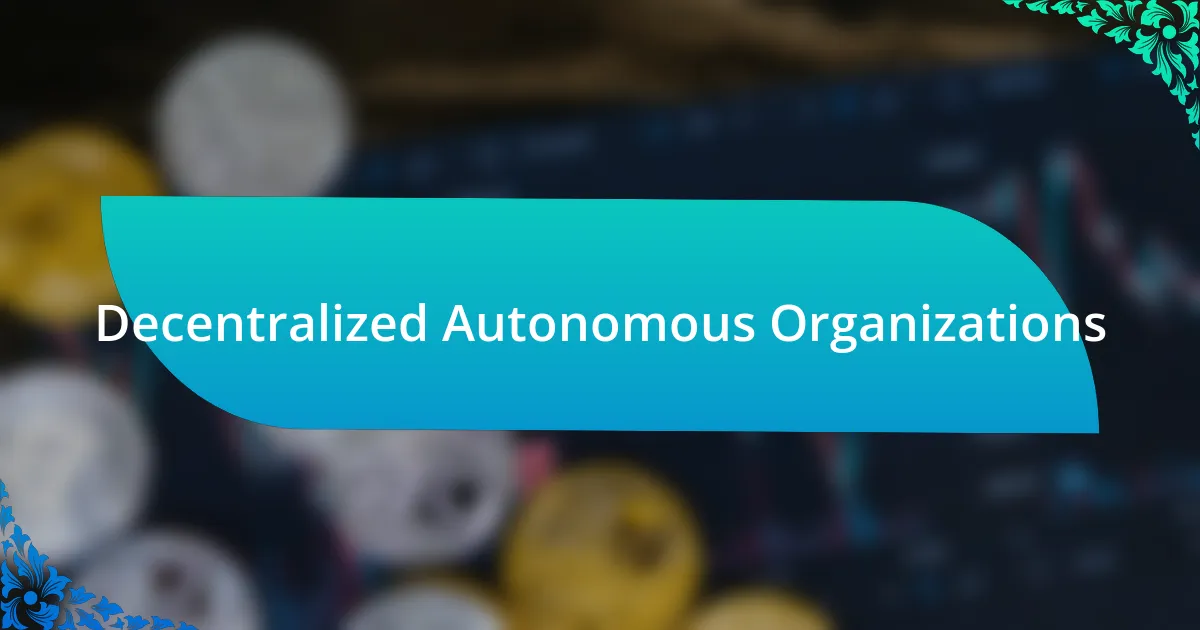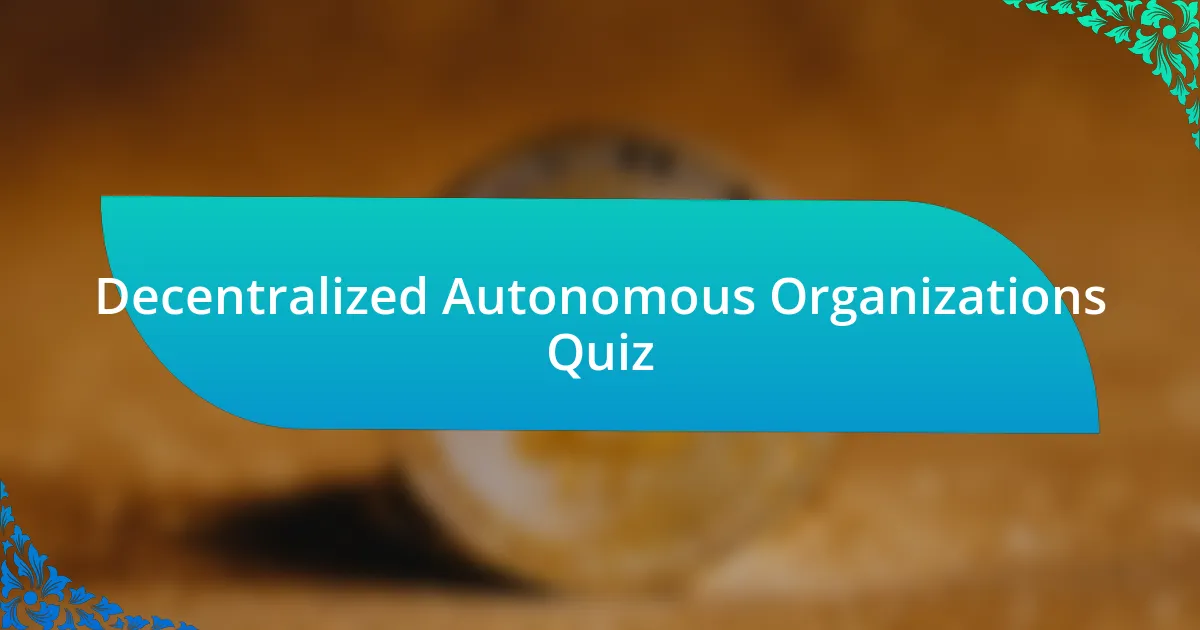
Start of Decentralized Autonomous Organizations Quiz
1. What defines the operational framework of a Decentralized Autonomous Organization (DAO)?
- A DAO Constitution detailing governance rules.
- A traditional administrative hierarchy.
- A contract with specific legal terms.
- A central authority managing operations.
2. In what way do smart contracts contribute to the functioning of DAOs?
- Smart contracts automate decision-making and enforce rules.
- Smart contracts store personal data of users securely.
- Smart contracts serve as a backup for traditional leadership roles.
- Smart contracts control financial markets and exchanges.
3. What is the process through which members propose changes in a DAO?
- Voting System
- Proposal Process
- Fund Allocation
- Membership Approval
4. How does a DAO ensure that decisions reflect the collective will of its members?
- Decisions are made by a single leader.
- Only developers make decisions.
- Random selection determines outcomes.
- Members vote on proposals.
5. What role do tokens play in determining voting power within a DAO?
- Tokens represent voting rights and influence in decision-making within a DAO.
- Tokens dictate the length of time a member can participate in a DAO.
- Tokens function as membership fees for joining a DAO.
- Tokens determine the financial contributions of members in a DAO.
6. Can a DAO change its governance structure, and if so, how?
- Yes, changes require approval from a central authority, not members.
- No, a DAO is fixed in its governance structure once established.
- Yes, but only the Executive Board can make changes to governance.
- Yes, a DAO can change its governance structure through member voting and proposals.
7. What are some challenges faced by DAOs in governance decision-making?
- Lack of clear governance structures
- Excessive centralization of power
- Inconsistent user interface design
- High transaction fees
8. How do DAOs differ from traditional companies in terms of structure and governance?
- DAOs make decisions based solely on the majority vote of shareholders without member engagement.
- DAOs are managed by a single leader who enforces decisions independently.
- DAOs operate under strict hierarchical management by a CEO and board of directors.
- DAOs are governed by member voting and smart contracts instead of a centralized board.
9. What is the importance of transparency in a DAO’s operations?
- It allows for secret decision-making processes.
- It gives centralized control to one member.
- It ensures accountability and trust among members.
- It restricts member participation in governance.
10. How do DAOs fund their projects or initiatives?
- Crowdfunding
- Personal Savings
- Bank Loans
- Corporate Sponsorship
11. What is a common reason for the failure of a DAO?
- Excess funding
- Lack of member engagement
- Centralized control
- High transaction fees
12. How can community engagement be fostered within a DAO?
- Hiring a central authority
- Implementing community voting initiatives
- Ignoring feedback from members
- Limiting member participation
13. What legal frameworks currently exist for DAOs operating on Ethereum?
- DAOs are controlled entirely by off-chain regulations and cannot operate under a digital framework.
- The DAO`s governance models are defined by legal entity forms like LLCs or non-profits for protections.
- DAOs must comply with all federal laws without exception, rendering them unclassifiable.
- DAOs operate solely under traditional corporate law without any special provisions.
14. How does the concept of decentralization enhance a DAO’s resilience?
- It centralizes decision-making, allowing faster responses.
- It ensures all decisions are made by a single leader.
- It limits participation to a small elite group of members.
- It distributes power across many members, reducing single points of failure.
15. What methods do DAOs use to resolve disputes between members?
- Random selection of members
- Third-party arbitration
- Voting and consensus mechanisms
- Public opinion polls
16. What specific Ethereum features are advantageous for DAOs?
- Centralized control and contracts
- Physical meetings and paper voting
- Fixed management and audits
- Smart contracts and token-based governance
17. In what ways can DAOs innovate beyond typical organizational models?
- DAOs rely solely on traditional board structures for decision making.
- DAOs follow strict regulations imposed by central authorities.
- DAOs operate without any voting or member participation.
- DAOs can create new economic models through community-driven funding.
18. How do DAOs track and measure member contributions?
- Managing personal inboxes and emails.
- Random surveys and polls.
- Monthly newsletters and updates.
- Member voting records and contributions.
19. What is the significance of proposal thresholds in DAO voting?
- Proposal thresholds are a requirement for all DAOs to have an annual budget.
- Proposal thresholds restrict the number of proposals submitted in a given period.
- Proposal thresholds ensure that a minimum level of support is needed for a proposal to be considered valid.
- Proposal thresholds are used to determine the amount of funding each proposal receives.
20. How can reputation systems influence member behavior in a DAO?
- Reputation systems can result in automatic penalties for all voting outcomes.
- Reputation systems can encourage members to contribute positively and follow community guidelines.
- Reputation systems can eliminate the need for any form of voting or decision-making.
- Reputation systems can lead to increased fees for transactions among members.
21. What impact do external regulations have on the operation of DAOs?
- External regulations enhance member voting rights and engagement.
- External regulations simplify the governance structure of DAOs.
- External regulations can impose compliance requirements, affecting DAO operations.
- External regulations have no effect on DAO operations or decisions.
22. How do DAOs evolve over time with changing member interests?
- DAOs remain static and do not evolve over time as interests shift.
- DAOs evolve by appointing a central leader to make decisions for members.
- DAOs adapt through member-led proposals and voting on changes to protocols.
- DAOs change automatically without needing input from members.
23. In what scenarios might a DAO choose to use hybrid governance?
- When it aims to eliminate member participation completely.
- When it needs to balance member voting with expert input.
- When it wants to restrict decision-making to a central authority.
- When it desires full control by a single individual.
24. What role does community consensus play in the functioning of DAOs?
- Community consensus allows a single leader to make all decisions.
- Community consensus eliminates the need for rules in a DAO.
- Community consensus guides decision-making within a DAO.
- Community consensus restricts member participation in governance.
25. How does a DAO utilize data analytics for improvements?
- DAOs use data analytics to create traditional hierarchies.
- DAOs analyze member voting patterns to refine governance strategies.
- DAOs collect user data for targeted advertising campaigns.
- DAOs rely solely on external surveys for community feedback.
26. What risks do members face when participating in a DAO?
- Mandatory face-to-face meetings twice a month
- High chances of becoming a CEO
- Guaranteed profits for all members
- Security vulnerabilities and smart contract bugs
27. How do DAOs leverage token economics for sustainability?
- DAOs manage sustainability through external funding only.
- DAOs use token incentives to encourage participation and ensure fund stability.
- DAOs rely solely on traditional investments to sustain operations.
- DAOs have no financial incentives for member engagement or support.
28. How can the performance of a DAO be assessed objectively?
- By evaluating the voting outcomes and member participation levels.
- By assessing the number of tokens held by members.
- By analyzing the social media presence of the organization.
- By comparing the total funds in the treasury against expenses.
29. What strategies do DAOs employ to onboard new members effectively?
- Relying solely on social media outreach.
- Integrating token systems and providing guidance.
- Holding exclusive events for leading members only.
- Creating complex regulations for membership.
30. How important is community reputation for a DAO’s success?
- Somewhat irrelevant
- Extremely important
- Moderately significant
- Not important at all

Congratulations! You’ve Successfully Completed the Quiz
Thank you for participating in our quiz on Decentralized Autonomous Organizations (DAOs). We hope you found the experience enjoyable and informative. Through this quiz, you’ve likely gained insights into how DAOs function, their benefits, and their impact on various industries. Understanding these concepts is crucial as DAOs are revolutionizing traditional organizational structures.
Many participants discover new perspectives on governance, transparency, and community-driven initiatives through DAOs. You may have learned about the blockchain technology that powers these organizations and how it contributes to their effectiveness. Additionally, the quiz may have prompted you to think critically about the future of organizational management and how decentralized systems can foster innovation and collaboration.
To deepen your knowledge on DAOs, we invite you to explore the next section on this page. This segment will provide you with comprehensive information and resources about Decentralized Autonomous Organizations. Whether you’re a newcomer or have some background knowledge, you’ll find valuable materials to enhance your understanding of this exciting topic.

Decentralized Autonomous Organizations
Introduction to Decentralized Autonomous Organizations
Decentralized Autonomous Organizations (DAOs) are digital entities that operate on blockchain technology. They function through smart contracts, which are self-executing contracts with the agreement directly written into code. DAOs eliminate the need for centralized control by allowing participants to engage in decision-making collectively. This model enhances transparency and promotes trust among members. DAOs are often used for governance, fund management, and collaborative projects.
Key Characteristics of DAOs
DAOs possess unique features that differentiate them from traditional organizations. They are decentralized, meaning no single entity has control over the organization. Governance is executed through a voting mechanism, where members use tokens to express their preferences. DAOs are autonomous, relying on programmed protocols to enforce rules and automate processes. Additionally, they are transparent, as all transactions and decisions are recorded on a public ledger, ensuring accountability among members.
Governance Models in DAOs
Governance models in DAOs dictate how decisions are made and who gets to influence outcomes. Common models include token-based governance, where voting power is proportional to the number of tokens held. Some DAOs adopt quadratic voting, allowing members to express varying levels of support for proposals. Others may incorporate multisig wallets, requiring multiple signatures for significant transactions. Each model influences participation and the complexity of governance.
Use Cases of Decentralized Autonomous Organizations
DAOs are applied across various industries and scenarios. They are prominent in the cryptocurrency space, managing community funds and organizing collective investments. Art and entertainment projects utilize DAOs to fund creative endeavors through member contributions. Moreover, DAOs are employed in philanthropic efforts, allowing communities to pool resources for social impact initiatives. These diverse applications showcase the versatility of the DAO structure.
Challenges Facing Decentralized Autonomous Organizations
DAOs face several challenges that can hinder their effectiveness. Governance issues may arise from token distribution, leading to centralization of power among a few. Regulatory uncertainty poses risks as governments seek to classify and regulate DAOs. Additionally, technical vulnerabilities can expose DAOs to hacks and exploits, undermining trust. Finally, ensuring active participation remains a challenge, as engagement levels can fluctuate among members.
What is a Decentralized Autonomous Organization?
A Decentralized Autonomous Organization (DAO) is a digital organization represented by rules encoded as a computer program. It is designed to be transparent, self-governing, and operate without a central authority. DAOs utilize blockchain technology for their governance and execution of decisions. This structure allows for decisions to be made collectively by members through a consensus mechanism, often involving voting on proposals. The concept gained prominence with the advent of Ethereum in 2015, which supports smart contracts capable of governing DAOs.
How do Decentralized Autonomous Organizations operate?
Decentralized Autonomous Organizations operate through a set of smart contracts that automate decision-making processes. Members of the DAO hold tokens that represent voting power, allowing them to propose changes and vote on governance issues. The execution of decisions is automated within the blockchain, ensuring trust and transparency. This eliminates the need for a traditional management structure, as rules and operations are predefined in the code. For example, the MakerDAO has successfully implemented a DAO framework to govern its stablecoin, DAI, demonstrating operational efficiency.
Where are Decentralized Autonomous Organizations commonly used?
Decentralized Autonomous Organizations are commonly used in the blockchain ecosystem for various purposes, including venture capital, charitable organizations, and community governance. They are prevalent in decentralized finance (DeFi) platforms, allowing members to manage funds collectively. DAOs like Uniswap enable users to vote on protocol changes and liquidity incentives, showcasing their utility in governance-related tasks within blockchain networks.
When did Decentralized Autonomous Organizations first emerge?
Decentralized Autonomous Organizations first emerged with the introduction of smart contracts on the Ethereum blockchain in 2015. The first notable DAO was “The DAO,” launched in April 2016, which raised over $150 million in Ether through crowdfunding. However, it faced challenges when it was hacked, leading to significant discussions about security and governance in DAOs. Despite this setback, the concept has evolved and expanded significantly in the following years, with many new DAOs established across various sectors.
Who can participate in a Decentralized Autonomous Organization?
Anyone can participate in a Decentralized Autonomous Organization, provided they hold the organization’s tokens that grant them voting rights. Participation typically involves joining through cryptocurrency wallets and acquiring the necessary tokens. Different DAOs may have specific requirements for membership or participation, yet most emphasize inclusivity. For instance, in DAOs like Compound, users can provide liquidity and earn governance tokens, allowing them to take part in decision-making processes.

